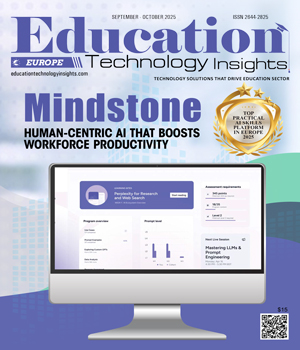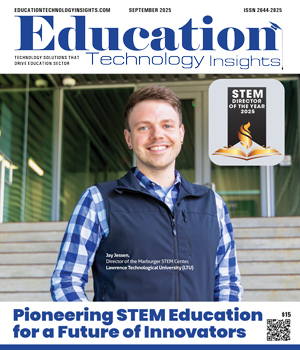THANK YOU FOR SUBSCRIBING
Be first to read the latest tech news, Industry Leader's Insights, and CIO interviews of medium and large enterprises exclusively from Education Technology Insights
The Revolutionizing Education Space
Robert Renaud, VP & CIO, Dickinson College
 Robert Renaud, VP & CIO, Dickinson College
Robert Renaud, VP & CIO, Dickinson College
Embracing Cloud Computing
Cloud computing has obvious benefits in the education space. It allows us to stand up systems quickly and to scale them to meet changing needs. It shifts some of the burden associated with on premise applications such as upgrades and maintenance patches to vendors. And it fits more naturally into a mobile workforce using a range of platforms to access information. Like many institutions, Dickinson College operates a mix of cloud and on premise applications. This mix challenges the IT organization to ensure security and interoperability among disparate and evolving products. For end users the fact that user interfaces for cloud products can change without warning can be unnerving. Here we need to educate our user communities to become more agile in the face of disruptive change.
“We need to educate our user communities to become more agile in the face of disruptive change”
Proactively Using Data to Drive Business Decisions
This problem faces IT organizations across higher education. Decision makers need accurate, up to date information to drive decision making. Some legacy platforms in particular were not designed with this need in mind, so business intelligence tools are brought to bear to meet this requirement. Increasingly, software applications have this capability built in. Data needs vary from institution to institution, so IT organizations need to find paths appropriate to their organizational cultures. At Dickinson College this partly takes the form of IT staff embedded in customer departments who become subject matter experts able to meet and anticipate data reporting needs.
Stimulating Innovation
The approach taken to fostering innovation varies by type of institution and by the distinct organizational culture of a college or university. In the case of Dickinson College, a selective liberal arts college of 2400 students chartered in 1783, the scale of the institution allows us to work with faculty and staff in an individualized basis. Here the approach is to constantly match the needs of end users with the best tech solutions. In larger institutions, this may not be possible.
The Remodeled CIOs Role
The CIO remains the most senior leader on campus responsible for coherent, forward leaning investments in information technology. This role has become more challenging in recent years as departments achieve increasing autonomy with the advent of best of breed cloud products. Although this trend has delivered benefits to end users, the need to align systems at the enterprise level continues to fall to the IT organization. The other development weighing on the role of the CIO is the burden of increasing government regulation, industry complianceand by threats to the campus network. Although responding to the information security challenge is essential, it drains resources away from work that might directly enhance the end user experience.
Keeping Pace with the Market Change
How an institution responds to business transformation varies according to institutional culture. Dickinson takes a relatively cautious approach to disruptive change and may be characterized as a late adopter. This conforms to the deliberate approach taken by the college as a whole. Using a model in which IT staff are embedded in end-user departments and the IT organization provides project management guidance, opportunities to exploit new and emerging technologies arise organically from the campus community.
Making the Infrastructure Future Ready
The advent of digital content and mobile platforms has dramatically shaped infrastructure investments at Dickinson College. To provide some perspective when I was appointed CIO in 2004 we had a single wireless access point and an Internet connection of 50 meg. Today we have over 1200 access points and a 3 gig connection. It is not just digital content that has shaped these changes, but also its nature. In particular streaming video such as Netflix led us to triple the size of our Internet connection in the summer of 2016 with the ability to scale up to 10 gig to meet future needs
Changing Campus Life and Learning
The Internet of Things has only started to change campus life. For a college like Dickinson that has many historic buildings years we can anticipate huge challenges in retrofitting facilities to leverage the power of the internet of Things. I suspect that this process will make the expansion of WiFi across every building on campus seem trivial. Apart from physical facilities I expect the Internet of Things to present fresh opportunities for location based learning and business operations. Here we will need to wait for regulatory bodies and the industry to develop and implement technical standards to ensure security and seamless interoperability.
Check Out:
Overview | CIOReview
Crunchbase | CIOReview
Glassdoor | CIOReview
Owler | CIOReview
Zoominfo | CIOReview
CIOReview Clients: Nous Systems
Read Also
Empowering Learners Practical Integration of Inquiry-Based Learning and Scaffolding in the Classroom
Unveiling the Future of Education: Exploring the Elements of a Smart Campus Ecosystem
Building Trust in the Educational Software Ecosystem
A Learning Path Curved Via Technology
Crisis as a Catalyst for Change and Transformation

I agree We use cookies on this website to enhance your user experience. By clicking any link on this page you are giving your consent for us to set cookies. More info






















